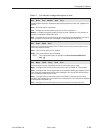
Configuration Options
C-12
3160-A2-GB21-80March 1999
Table C-5. Data Port Channel Configuration Options (1 of 4)
Channel Config:
Dsply Clear DTE Prt1 Prt2 Prt3 Prt4
_______________________
NOTE: The configuration options described in this table are made available by
selecting Prt1, Prt2, Prt3, or Prt4 from the Channel Config screen. Table C-4
describes the DTE configuration options. For information about the
operation of Display and Clear, refer to
Configuring DS0 Channels
in
Chapter 3,
Operation
.
Data Port Channel. Allows the assignment of a particular port to DS0 channels on either
the network interface, the DTE Drop/Insert (DSX-1) interface, or another port (see the
Assign To configuration option below).
NOTE: For 2-port DSU/CSUs, only Ports 1 and 2 are available; for 1-port
DSU/CSUs, only Port 1 is available, and only the Port Rate configuration
option appears if you select this port.
Assign To: NET
Next NET DTE Prt
n
Prt
n
Prt
n
Prev
Data Port Channel Allocation Destination. Allows you to assign this port to DS0 channels
on either the network interface, the DTE Drop/Insert (DSX-1) interface, or another port.
NET – Assigns this port to DS0 channels on the network interface.
DTE – Assigns this port to DS0 channels on the DTE Drop/Insert (DSX-1) interface. If
the DTE Drop/Insert (DSX-1) interface is disabled, this selection does not appear.
Prt
n
– Assigns this port to another port, where
n
is the port number of all available ports
except the port selected from the Channel Config screen. For example, if you select Prt1
from the Channel Config screen, Prt2, Prt3, and Prt4 appear for 4-port DSU/CSUs. Use
this feature to designate a port as a backup port. You can attach an external backup
device to Prt
n
and manually assign the selected port to the backup port (i.e., route data
from the selected port to the backup port). When a port is assigned to another port, DSR
is turned on. Selecting Prt
n
and Next takes you directly to the Port Rate configuration
option, bypassing the Assign By configuration option. EDL (for 2-port and 4-port
DSU/CSUs) does not operate when a synchronous data port is assigned to another
synchronous data port. Therefore, if EDL is enabled, it is ignored.
NOTE: Changing this configuration option from one T1 interface to the other (NET
or DTE) deallocates all DS0 channels assigned to the previous interface.
Assign By: Block
Next Block ACAMI Chan Prev
Data Port Channel Allocation Method. If NET or DTE is selected using the Assign To
configuration option, this configuration option designates the method for assigning DS0
channels to the destination T1 interface.
Block – Allocates DS0 channels to this port by the block method.
ACAMI – Allocates DS0 channels to this port by the Alternate Channel Alternate Mark
Inversion method. The difference between block and ACAMI is that the number of
channels allocated with ACAMI is double the number needed for the port rate. With
ACAMI, every alternate DS0 channel does not carry data from the port but always
transmits and receives all ones.
Chan – Allocates DS0 channels to this port by the individual channel method.
NOTE: Changing this configuration option from one method to another (Block,
ACAMI, or Chan) deallocates all DS0 channels assigned to either the
network interface or the DTE Drop/Insert (DSX-1) interface.


















